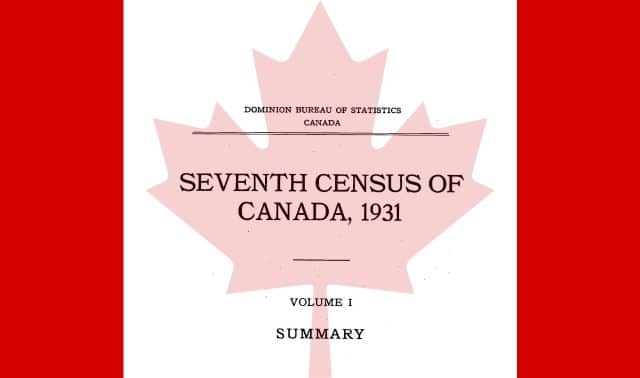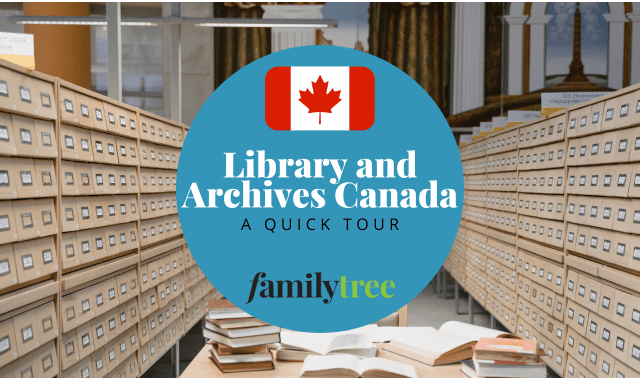Sign up for the Family Tree Newsletter! Plus, you’ll receive our 10 Essential Genealogy Research Forms PDF as a special thank you.
Get Your Free Genealogy Forms
"*" indicates required fields
The 1930s in Canada were a decade of dust and depression. Canadians faced hard times: Working-class men were “riding the rails” in search of work, the Prairies were plagued by drought and pestilence, and new restrictions severely limited immigration into the country.
Just two years into the Great Depression, the 1931 census of Canada (released to the public on 1 June 2023) gathered data on Canada’ population, households and economy, and offered a picture of life during that difficult time. Conducted by the Dominion Bureau of Statistics, it was the country’s seventh census since Confederation.
The 1931 census encompassed a wide array of demographic information concerning the Canadian population. Age, gender, marital status, familial relationships, ethnicity, religion and education were among the questions recorded. Given the hard economic times, the government was particularly concerned with the occupations and unemployment conditions of Canadians.
Here’s what you can learn in the 1931 census of Canada, and how to find records online.
Background: Canada Between 1921 and 1931
Canada conducted national censuses every 10 years from 1871 to 1971, providing glimpses into daily life each decade. The period between the 1921 and 1931 censuses had a profound impact on the country and its people, and shaped the demographic landscape as well as immigration policies.
Population
Canada’s population stood at 10,376,786 individuals in the 1931 census, marking an increase of 18.1% from the 1921 census population count. A substantial part of this growth occurred in the latter half of the 1920s, highlighting the changing dynamics of the Canadian population during that period.
Immigration
Following the conclusion of the First World War, British immigration to Canada gradually declined as the British economy recovered and offered improved opportunities.
To counteract this decline and encourage immigration, Canada and the United Kingdom collaborated to establish government-assisted settlement programs. The Empire Settlement Act (1922) provided support and incentives for British immigrants, especially farmers, farm laborers and domestic workers. it also offered financial assistance for land-development, farm equipment and other resources necessary for establishing a new life in Canada.
Many of the new immigrants who arrived via the Empire Settlement Act chose to settle in the Prairie provinces of Manitoba, Saskatchewan and Alberta. These provinces were particularly attractive due to their vast expanses of fertile land, offering ample agricultural development and settlement opportunities. (A special 1926 census of just the Prairie provinces provides insight on the contemporary population and agriculture.)
The wave represented a substantial increase compared to the preceding five years, when only 34,000 immigrants arrived from the British Empire.
By the end of the decade, the Canadian government sought to curb immigration. New immigration acts restricted the number of immigrants entering the country (particularly those from non-European countries) and enacted stricter criteria for admission. This change in policy had a notable impact on Canada’s demographics and ethnic makeup, shaping immigration patterns and contributing to the development of a predominantly white European Canadian society.
Women’s rights
The Supreme Court issued the landmark “Persons Case” in 1926, in favor of the “Famous Five” activist women from Alberta. The ruling established women as “persons” under Canadian law and granted them the rights to serve in the Senate and make legal decisions, a significant milestone in women’s rights and equality in Canada.
Governance and international politics
In 1926, the Balfour Declaration established the United Kingdom and the Dominions of the British Empire (which included Canada) to be “autonomous Communities within the British Empire, equal in status, in no way subordinate one to another in any aspect of their domestic or external affairs, though united by a common allegiance to the Crown, and freely associated as members of the British Commonwealth of Nations.”
This marked a significant moment in Canadian history, as it assured Canadian autonomy and self-governance. The declaration was upheld and expanded upon in 1931 with the Statute of Westminster.
Economy
The Great Depression struck in 1929 and had a profound, far-reaching impact on Canada, with its effects being particularly severe between 1930 and 1933. This economic crisis brought about significant changes throughout the country.
One of the most striking aspects of the Depression was the sharp decline in public and private spending, which had a ripple effect. Between 1929 and 1933, Canada’s gross domestic expenditure fell by a staggering 42%. Unemployment skyrocketed and reached around 30% by 1933. Many Canadians found themselves without work, resulting in widespread poverty, homelessness and illness.
How the 1931 Census Was Conducted
The 1931 census was conducted beginning on 1 June 1931. It employed the de jure system, used for all Canadian census enumerations from 1871, that enumerates people in their home or usual place of abode as of June 1 (rather than where they were at the time the enumerator arrived).
Enumeration continued daily (excluding Sundays) until the enumerator finished their assignment. Individuals who failed to provide truthful answers or refused to cooperate with the enumerator could receive fines ranging from $20 to $100 or imprisonment for up to 90 days.
Enumerators played a crucial role in collecting accurate and detailed information from the population, even taking an oath to perform their duties faithfully and accurately. They were assigned to specific sub-districts and were responsible for traveling door to door and farm to farm to collect information.
The enumeration included several schedules, but only Form 1—the population schedule—has been preserved, microfilmed, digitized and made publicly available. All other 1931 census schedules were destroyed. (Only the 1871 census, the first enumeration taken after the Confederation of Canada, has all schedules preserved.)
Mechanical equipment still tabulated and compiled 1931 census data. But a Dominion Bureau of Statistics employee developed an innovative sorter-tabulator that increased the speed of processing the census data fifty-fold. This new machine could read the data on the entire data card, instead of analyzing it column by column.
Tip: Single men were the most difficult to accurately document in this census due to their transient nature in looking for work. They may have been recorded twice or missed altogether.
1931 Census Questions
Focusing on the population, Form 1 requested information about every person living in the household on census day for a total of 40 questions. The head of each family or household, usually the husband or father, provided the necessary information to the enumerator, who recorded the answers in each column on the bilingual form.
The 1931 census generally asked more questions than preceding enumerations, and had five more than the 1921 census. Like the 1891 and 1921 counts, the 1931 census asked for birthplaces of everyone’s parents, and (like the 1911 census) had several questions devoted to occupation and unemployment.
The details recorded in the 1931 census provide insights into the demographics, living conditions, language proficiency, religion, education and employment status of our Canadian ancestors during the early years of the Great Depression.
Below are the questions asked. Consult the enumerator instructions for more context, as well as descriptions of what responses to each question mean:
General Household Information
- Columns 1 and 2: Dwelling number and number of family assigned by the enumerator, in order of visitation.
Names and Address
- Column 3: The name of each person in the household, starting with the surname followed by the first name in full. The order of recording individuals was as follows: head of the household (usually a man), his wife, his sons and daughters in age order, and his other relatives, then servants, boarders, lodgers or other persons residing in the family or household.
- Column 4: The address of each dwelling was to include the house number, apartment number (if applicable), and street name. For rural regions, this column listed the name of the township, lot, parish or cadastral number. In Manitoba, Saskatchewan, and Alberta, additional details—such as the section, township, range, meridian, and (in some cases) parish—were recorded.
Description of Home
- Columns 5 and 6: Whether the home was owned or rented, and the value of the home (if the former) or the amount of rent paid per month (if the latter).
- Columns 7 and 8: The “class” of the home (apartment, single-family, semi-detched, etc.) and the construction materials (stone, brick, etc.) making up its exterior walls.
- Column 9: How many rooms occupied by the family.
- Column 10: If the family owned a radio, reflecting the growing popularity of radio as a form of entertainment and information.
Personal Details
- Column 11: Relationship to head of household.
- Column 12: Sex: M for male or F for female.
- Column 13: Marital status: S for single, M for married, W for widowed or D for divorced.
- Column 14: Age at last birthday, as of June 1.
- Columns 15–17: Place of birth for each individual as well as their father and mother, reported as a country (for foreign-born) or province/territory (if Canadian-born). Entries for foreign-born individuals were supposed to reflect where those locations were as of 1931, important for understanding birthplaces in countries whose borders changed as a result of World War I. Individuals born in the British Isles were to provide the specific country (England, Wales, etc.) rather than “Great Britain” or “British Isles.”
Immigration and Ethnicity
- Columns 18 and 19: Years of immigration and naturalization, if applicable.
- Column 20: Nationality, namely the country to which the person swears allegiance (including Canadian, for Canadian citizens).
- Column 21: Racial origin (ethnicity), which was traced through the father (except for Indigenous peoples, whose origin was traced through the mother).
Language, Religion and Education
- Columns 22–24: Each person’s ability to speak English and French. Languages other than English or French that were spoken as the mother tongue were also noted.
- Column 25: Each person’s religion to which they adhered or belonged. The most-common religious denominations in 1931 Canada included Roman Catholicism, the United Church, Anglicanism, Lutheranism and Baptist congregations.
- Column 26: Ability to read and write.
- Column 27: Months at school since 1 September 1930 for individuals between the ages of 5 and 20, inclusive.
Occupation and Industry
- Column 28: Occupation for individuals 10 years of age and older, described in “words which most accurately indicate the particular kind of work.” Income here indicates someone who was independently wealthy, and None was used for someone who had “no gainful occupation.” A woman who was primarily engaged in homemaking was recorded as Homemaker.
- Column 29: The industry or business in which a person was engaged or employed, with some level of specificity (e.g., soap factory instead of just factory, or building construction instead of construction). Columns 29 and 30 were left blank for individuals not gainfully employed.
- Column 30: Class of worker: E for employer (e.g., a shopowner), W for wage or salary worker, O for own account (self-employed), and NP for family members employed without pay but who contributed to the family income.
- Column 31: Total earnings in the past 12 months were recorded for every worker who had an occupation or trade.
Unemployment
- Column 32: If at work on 1 June 1931, asked only of respondents who had an occupation in column 28 and were listed as employees/workers in column 30.
- Column 33: Why not at work if respondent answered No to column 32. Possible responses include “no job” (nor any promise of a job nor understanding of being employed), illness, accident, holiday, strike or temporary layoff.
- Columns 34–40: Number of weeks unemployed in the past 12 months. Column 34 must be equal to the sum of columns 35 through 40, which provided additional detail:
- Column 35: Number of weeks with no job, nor prospect of returning to a former job
- Column 36: Number of weeks out of work because of illness
- Column 37: Number of weeks out of work because of an accident to himself
- Column 38: Number of weeks out of work because of a strike or lockout
- Column 39: Number of weeks out of work because of “temporary layoff,” such as a factory being closed for repairs
- Column 40: Number of weeks out of work because of other causes
When Was the 1931 Census of Canada Released?
Privacy laws in Canada restrict access to census records for 92 years. For the 1931 census, those restrictions ended on 1 June 2023, when the Library of Archives Canada (LAC) released images of census documents to the public. Census images were originally browse-only, viewable by district and sub-district.
In preparation for the release, LAC developed a 10-step plan for digitizing, indexing and transcribing census images. Through the project, more than 230,000 images have been scanned from 187 microfilm reels, each page undergoing meticulous verification. The digitized images are then matched to the geographic districts and sub-districts used for enumeration.
LAC has also partnered with Ancestry.com and FamilySearch to index and transcribe all the fields of the census forms using artificial intelligence technology. The 1931 index is available on Ancestry.com, FamilySearch, MyHeritage, and the LAC’s Census Search after additional testing. The census is also browse-only at Findmypast.
Despite privacy restrictions on data about individual people, compiled statistical information about the 1931 census has been publicly available for decades. You can find all 13 volumes of Seventh Census of Canada, 1931, published by the Dominion Bureau of Statistics, on the Canadian government’s publications website and the Internet Archive (see a collection of links through the University of Toronto). These volumes are an excellent resource for studying and understanding Canada’s demographic and socioeconomic aspects during the early years of the Great Depression.
By comprehensively documenting the population, the 1931 Census of Canada provides genealogists and family historians invaluable data about their ancestors’ lives and the country’s social, economic and demographic history during one of the worst periods in Canadian history.
Last updated, December 2023.







